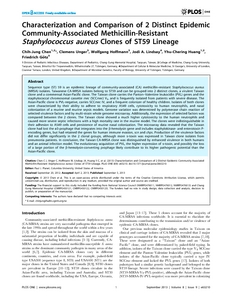Chen, CJ; Unger, C; Hoffmann, W; Lindsay, JA; Huang, YC; Götz, F
(2013)
Characterization and Comparison of 2 Distinct Epidemic Community-Associated Methicillin-Resistant Staphylococcus aureus Clones of ST59 Lineage.
PLoS One, 8 (9).
e63210 - e63210 (11).
ISSN 1932-6203
https://doi.org/10.1371/journal.pone.0063210
SGUL Authors: Lindsay, Jodi Anne
![[img]](https://openaccess.sgul.ac.uk/102611/1.hassmallThumbnailVersion/pone.0063210.pdf)  Preview |
|
["document_typename_application/pdf; charset=binary" not defined]
Published Version
Download (3MB)
| Preview
|
Abstract
Sequence type (ST) 59 is an epidemic lineage of community-associated (CA) methicillin-resistant Staphylococcus aureus (MRSA) isolates. Taiwanese CA-MRSA isolates belong to ST59 and can be grouped into 2 distinct clones, a virulent Taiwan clone and a commensal Asian-Pacific clone. The Taiwan clone carries the Panton-Valentine leukocidin (PVL) genes and the staphylococcal chromosomal cassette mec (SCCmec) VT, and is frequently isolated from patients with severe disease. The Asian-Pacific clone is PVL-negative, carries SCCmec IV, and a frequent colonizer of healthy children. Isolates of both clones were characterized by their ability to adhere to respiratory A549 cells, cytotoxicity to human neutrophils, and nasal colonization of a murine and murine sepsis models. Genome variation was determined by polymerase chain reaction of selected virulence factors and by multi-strain whole genome microarray. Additionally, the expression of selected factors was compared between the 2 clones. The Taiwan clone showed a much higher cytotoxicity to the human neutrophils and caused more severe septic infections with a high mortality rate in the murine model. The clones were indistinguishable in their adhesion to A549 cells and persistence of murine nasal colonization. The microarray data revealed that the Taiwan clone had lost the ø3-prophage that integrates into the β-hemolysin gene and includes staphylokinase- and enterotoxin P-encoding genes, but had retained the genes for human immune evasion, scn and chps. Production of the virulence factors did not differ significantly in the 2 clonal groups, although more α-toxin was expressed in Taiwan clone isolates from pneumonia patients. In conclusion, the Taiwan CA-MRSA clone was distinguished by enhanced virulence in both humans and an animal infection model. The evolutionary acquisition of PVL, the higher expression of α-toxin, and possibly the loss of a large portion of the β-hemolysin-converting prophage likely contribute to its higher pathogenic potential than the Asian-Pacific clone.
Statistics
Item downloaded times since 23 Oct 2013.
Actions (login required)
 |
Edit Item |




